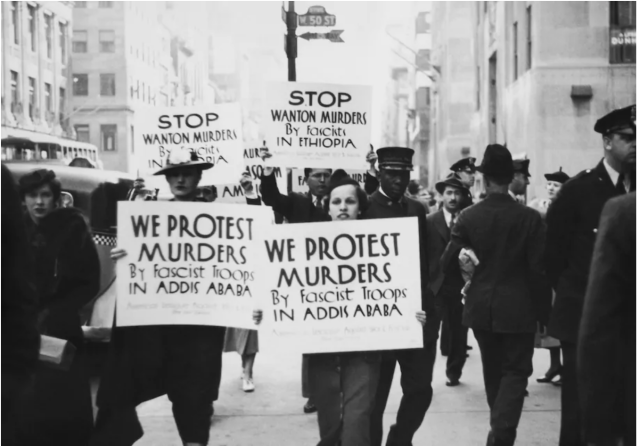 Members of the American League Against War and Fascism picket the Italian Consulate on Fifth Avenue, New York, protesting against the brutality of the Italian troops during their invasion of Ethiopia, May 1936. (Getty)
Members of the American League Against War and Fascism picket the Italian Consulate on Fifth Avenue, New York, protesting against the brutality of the Italian troops during their invasion of Ethiopia, May 1936. (Getty)
The Washington Post
On Aug. 3, 1935, a day so humid you could taste the air, 25,000 Black and White New Yorkers marched down Harlem’s Lenox Avenue to protest fascist Italy’s plans to invade Ethiopia. Ruled by Emperor Haile Selassie, Ethiopia was a League of Nations member and one of two African nations that had never been colonized. The urgency of the cause brought together Black labor, religious and pan-Africanist groups, Italian American leftists and the event’s sponsor, the Communist-linked American League against War and Fascism.
Often relegated to the margins of history, the Italo-Ethiopian War (October 1935-May 1936) brought the world home for America’s Black communities. It awakened many people to sentiments of belonging and allegiance that transcended national boundaries and sparked mass protests. Outside the United States, the war also galvanized many in the Black diaspora to the stakes of anti-racist and anti-fascist struggles. The mass reaction to the invasion of Ethiopia merits attention at a time when a new generation is engaging in sustained protest against racial injustice and authoritarian aggression is on the rise.
Ethiopia had a special significance for many in the Black diaspora. It was an ancient center of Christianity, and the Ethiopianism religious movement of the late 19th century drew on biblical reference to the country’s special role in fostering African nationalism and independence. Ethiopia also stood as a symbol of anti-imperial defiance and African modernity. In Adwa, in 1896, Ethiopians forced Italian armed forces to retreat, putting an end to Italy’s first attempt to occupy the country. Haile Selassie, then in his fifth year as emperor, also enjoyed global fame. He inspired Rastafari, a cultural and religious movement that considered him as a messianic figure. For millions, the invasion of Ethiopia imperiled Black freedom and dignity everywhere.
For the fascists, occupying Ethiopia was not merely payback for that humiliating defeat 40 years earlier, but a chance to implement dictator Benito Mussolini’s plan to make Italy an agent of white racial rescue. The fascist regime famously persecuted leftists and ethnic and religious minorities, but it also acted to correct perceived threats to the hegemony of white civilization. In 1927, years before Adolf Hitler came to power in Germany, Mussolini warned that white people could face extinction, while “black and yellow people” were “at our doors,” armed with “a consciousness of the future of their race in the world.”
New York City became a hub of activities on both sides of the Italo-Ethiopian war. A rally held at Madison Square Garden on Sept. 26, less than a week before the invasion, brought out more than 10,000 to hear civil rights leader W.E.B. Du Bois, Paul Robeson and others speak about the impending disaster.
The rally was also a demonstration of racial unity: Whites, including many anti-fascist Italian Americans, made up three-quarters of the audience that cheered the sight of a 20-foot effigy of Mussolini being destroyed. Blacks and whites together boycotted Italian businesses, leading to confrontations around the city. Ethiopia built bridges between some New Yorkers — even as it drove others apart.
While some Italian Americans in New York protested Mussolini, others embraced him. These tensions came to a head when the invasion began on Oct. 3 and Italian troops poured into Ethiopia. Italian American and Black students brawled at Brooklyn’s P. S. 178 with lead pipes and ice picks, and a Black protest of Italian vendors at the King Julius General Market on Lenox and 118th Street turned into a riot. The New York City Police Department deployed 1,200 extra policemen on “war duty” to address the unrest. There, as in other American cities, demonstrators also met with police brutality.
—
Related:
Eskender A. Yousuf: Reflection on Lack of Solidarity With Blacks in Our Community
Ethiopian-Eritrean Trhas Tafere Reflects on Africans’ Perspective on Race in America
The Other Face of Privilege: An Ethiopian American Perspective by Amen Gashaw
Photos: Ethiopians Show Solidarity with Black Lives Matter in D.C.
An Open Letter to PM Abiy Ahmed Ali: By Lydia A. Gorfu
From Tadias Archives: African American & Ethiopia Relations
Watch: Mahdere Yared on The Long-Term Effects of Racism (TEDx Pine Crest School class of 2021)
Join the conversation on Twitter and Facebook.

























